
This video segment from the Nevada Department of Wildlife looks at various species of bats and how they impact the environment. [3:14]
- Subject:
- Science
- Material Type:
- Audio/Video
- Provider:
- PBS LearningMedia
- Date Added:
- 12/01/2022

This video segment from the Nevada Department of Wildlife looks at various species of bats and how they impact the environment. [3:14]

Students will engage in a lesson that teaches them to associate certain expressions and words with specific feelings. Included are a senses powerpoint, a model of a graphic organizer, and a video and picture of the students engaged in the lesson.
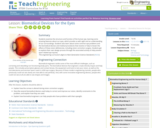
Students examine the structure and function of the human eye, learning some amazing features about our eyes, which provide us with sight and an understanding of our surroundings. Students also learn about some common eye problems and the biomedical devices and medical procedures that resolve or help to lessen the effects of these vision deficiencies, including vision correction surgery.
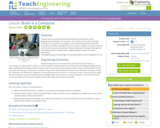
Students learn about the similarities between the human brain and its engineering counterpart, the computer. Since students work with computers routinely, this comparison strengthens their understanding of both how the brain works and how it parallels that of a computer. Students are also introduced to the "stimulus-sensor-coordinator-effector-response" framework for understanding human and robot actions.

In this video segment from Outdoor Nevada, learn about burrowing owls, yearlong residents of open, dry grassland and desert habitats, and the only owls that nest underground and are active both day and night. [1:43]
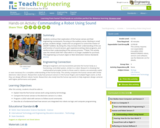
Students continue their exploration of the human senses and their engineering counterparts, focusing on the auditory sense. Working in small groups, students design, create and run programs to control the motion of LEGO® TaskBots. By doing this, they increase their understanding of the use and function of sound sensors, gain experience writing robot programs, and reinforce their understanding of the sensory process.
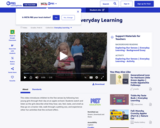
This video introduces children to the five senses by following two young girls through their day at an apple orchard. Students watch and listen as the girls describe what they hear, see, feel, taste, and smell as they go on a tractor ride, walk through a petting zoo, and experience other fun activities that the orchard offers. [2:31] Support materials are provided.

In this video from PBS Wisconsin Education and the University of Wisconsin-Madison Center for Healthy Minds, kids learn a technique to cultivate their attention through being aware of their senses. [1:00]

This video segment from Outdoor Nevada looks at the Gila monster's behavior, habitat, and unique adaptive characteristics. [3:55]

Students learn about the anatomy of the ear and how the ears work as a sound sensor. Ear anatomy parts and structures are explained in detail, as well as how sound is transmitted mechanically and then electrically through them to the brain. Students use LEGO® robots with sound sensors to measure sound intensities, learning how the NXT brick (computer) converts the intensity of sound measured by the sensor input into a number that transmits to a screen. They build on their experiences from the previous activities and establish a rich understanding of the sound sensor and its relationship to the TaskBot's computer.
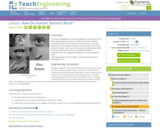
This lesson highlights the similarities between human sensors and their engineering counterparts. Taking this approach enables students to view the human body as a system, that is, from the perspective of an engineer. Humans have recreated most human sensors in robots – eyes, ears and sensors for temperature, touch and smell. The lesson inculdes a PowerPoint file that is programmed to run a Jeopardy-style game as a fun assessment tool.
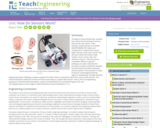
Through six lesson/activity sets, students learn about the functioning of sensors, both human and robotic. In the activities, student groups use LEGO MINDSTORMS(TM) NXT robots and components to study human senses (sight, hearing, smell, taste, touch) in more detail than in previous units in the series. They also learn about the human made rotation, touch, sound, light and ultrasonic sensors. "Stimulus-sensor-coordinator-effector-response" pathways are used to describe the processes as well as similarities between human/animal and robotic equivalent sensory systems. The important concept of sensors converting/transducing signals is emphasized. Through assorted engineering design challenges, students program the LEGO robots to respond to input from various LEGO sensors. The overall framework reinforces the theme of the human body as a system with sensors that is, from an engineering perspective. PowerPoint® presentations, quizzes and worksheets are provided throughout the unit.
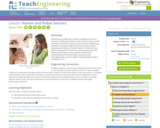
Students are provided with a rigorous background in human "sensors" (including information on the main five senses, sensor anatomies, and nervous system process) and their engineering equivalents, setting the stage for three associated activities involving sound sensors on LEGO® robots. As they learn how robots receive input from sensors, transmit signals and make decisions about how to move, students reinforce their understanding of the human body's sensory process.

This unit uses Wild Kratt videos, hands-on activities, and document resources to teach about animal senses. Extensions for further learning are also provided.

Explore the literary technique of imagery to see how sensory language contributes to the meaning and feeling of a poem in this animated video [1:23] from WNET. Discussion questions below help students to further apply their understanding before analyzing a text.

Teach language, vocabulary and listening comprehension with Celebrity Vocab clips! [2:33]

Students are introduced to various types of hearing impairments and the types of biomedical devices that engineers have designed to aid people with this physical disability.

A beautiful site that incorporates a story with your interactive exploration of shark anatomy. Use this site for it's great images and fun learning activity.

Information site provides examples of several animals and their amazing adaptations to their environments.

Describes experiments students can do to investigate the sense of smell. The experiments target either grades K-6 and 3-12.